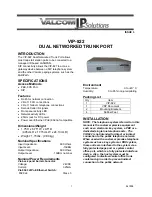
INS_NW7[E]/M_REV– 06/10/13 PAGE 49
INSTALLATION AND OPERATION MANUAL
NW7[E]/M
TECH SUPPORT: 1.888.678.9427
Advanced Settings
Figure 41: Advanced Settings for the Wifi Device Configuration.
Distance
Optimization
(Auto-ACK
Timeout)
Determines the distance of the connected station from the AP and automatically
adjusts the ACK timeout. This is disabled by default. If the stations are positioned
over a wide area at different distances from the AP, it is recommended to disable
this option to prevent the ACK timeout from fluctuating widely.
Distance (meters)
Specifies the distance between the AP and the station, if the previous option is
unchecked. Min: 300, Max: 12000 (80MHz), 24000 (40MHz), 48000 (20MHz). This
value may be set to slightly more than the physical distance between the AP and
the farthest station.
Chainmask
Selection
Sets the antenna port selection on the radio. For example, 2x2 means that 2
antennas are being used.
Note: The following options are for the device operating as an access point (AP).
Beacon Interval
Specifies the interval between beacon transmissions by the AP, in ms. A beacon is
a frame broadcast by the AP to synchronize the wireless network. For the multiple
VAP case, the beacons are transmitted evenly within this interval. Thus, if four VAPs
are created and the beacon interval is 200 ms, a beacon will be transmitted from
the radio portion every 50 ms, from each VAP in a round-robin fashion. The default
value of the interval is 100 ms.
Adaptive noise
immunity
Controls radio sensitivity in the face of noise sources. Adaptive noise immunity
allows the AP to reject spurs and non-WLAN noise. An advantage is that the AP
would have to spend less time decoding the signal, resulting in lower packet loss
rate.
Dynamic channel
selection
Automatically switches channel to avoid interference. Dynamic channel selection is
a feature to detect and avoid continuous wave (CW) interference. CW interference
or spurs cause the noise floor to be high. This stops transmissions as well as
causes receives to fail frequently. The noise floor is monitored by the calibration
logic. When the noise floor is above a threshold, the AP performs an automatic
channel selection. It would disconnect from the clients (it would already have due
to the interference) and move to a new channel. The clients are then expected to
re-associate with the AP on their own.
















































